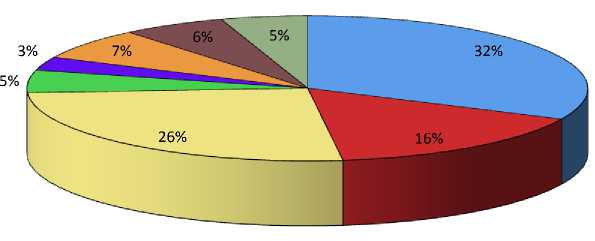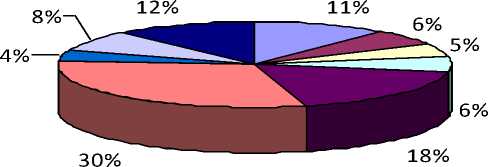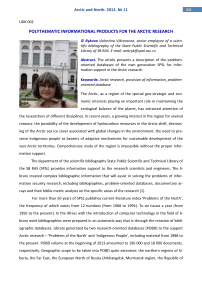Polythematic informational products for the Arctic research
Автор: Rykova V.V.
Журнал: Arctic and North @arctic-and-north
Рубрика: Informational recources
Статья в выпуске: 11, 2013 года.
Бесплатный доступ
The article presents a description of the problemoriented databases of the own generation SPSL for information support in the Arctic research.
Arctic research, provision of information, problemoriented database
Короткий адрес: https://sciup.org/148320362
IDR: 148320362 | УДК: 002
Текст научной статьи Polythematic informational products for the Arctic research
The Arctic, as a region of the special geo-strategic and economic interests playing an important role in maintaining the ecological balance of the planet, has attracted attention of the researchers of different disciplines. In recent years, a growing interest in the region for several reasons: the possibility of the development of hydrocarbon resources in the Arctic shelf, decreasing of the Arctic sea ice cover associated with global changes in the environment, the need to preserve indigenous people as bearers of adaptive mechanisms for sustainable development of the vast Arctic territories. Comprehensive study of the region is impossible without the proper information support.
The department of the scientific bibliography State Public Scientific and Technical Library of the SB RAS (SPSL) provides information support to the research scientists and engineers. The library created complex bibliographic information that will assist in solving the problems of information security research, including bibliographies, problem-oriented databases, documentary arrays and their biblio-metric analysis on the specific areas of the research [1].
For more than 50 years of SPSL publishes current literature index ‘Problems of the North’, the frequency of which varies from 12 numbers (from 1968 to 1994). To six issues a year (from 1995 to the present). In the 90-ies with the introduction of computer technology in the field of library work bibliographies were prepared in an automatic way that is through the creation of bibliographic databases. Library generated by two research-oriented databases (POBD) to the support Arctic research – ‘Problems of the North’ and ‘Indigenous People’, including material from 1988 to the present. POBD volume at the beginning of 2013 amounted to 196 000 and 18 000 documents, respectively. Geographic scope to be taken into POBD quite extensive: the northern regions of Siberia, the Far East, the European North of Russia (Arkhangelsk, Murmansk region, the Republic of
Karelia and Komi) and the polar regions of the abroad North – Sweden, Finland, Norway, Canada, the United States (Alaska), Denmark (Greenland).
The databases are based on the legal deposit of the national literature, the only beneficiary in Siberia is SPSL and foreign literature, coming to the library for international book exchange and purchased currency institutes of the Russian Academy of Sciences, and the resources remotely. Data set includes a variety of types of documents: monographs, articles from periodicals and scientific journals, conference proceedings, dictionaries, reference books, textbooks, dissertation abstracts, reviews, guidelines, patents, maps, atlases, deposited manuscripts and reports. The search of the databases available on the keywords in the title, abstract or translation, authors, editors, and place of publication, subject headings, language, document type or a combination of the several parameters.
In POBD ‘Problems of the North’ questions reflected the history of the development of nature and natural resources north of Eurasia and North America, the features of their topography, climate, water, surface and underground ice, soil, flora and fauna, ecosystems, including materials on human intervention Environmental and conservation of the Arctic and sub-Arctic regions, and the biomedical and sanitary problems of the North. Database covers a wide range of the socioeconomic problems of the Far North: natural resources, the development of productive forces, the settlement system, human resources, and quality of the life. A special place in this database occupies materials on the various aspects of the development of the northern peoples. Issues related to the northern equipment and technology are reflected in the subject heading ‘Provision of the production equipment and technology for the northern’, ‘Problems in the construction of the North’, ‘Problems of the development of the mineral resources in the North’, as well as a set of problems related to the transport development of the Arctic regions. In addition to the regional activities included in the database without specifying the date of the study area as they relate to the study of permafrost and operational issues associated with it, as well as adaptation to harsh environmental conditions. Polythematic DB structure ‘Problems of the North’ is shown in fig. 1.
Природа и природные ресурсы
Экологические проблемы

Экономические проблемы
Социальные проблемы
Проблемы строительства
Проблемы разработки полезных ископаемых
Проблемы сел. хоз-ва
Медицинские проблемы
Pic. 1Thematical structure POBD ‘Problems of the North’
In the database ‘Problems of the North’, the issues of the natural and environmental and socio-economic blocks are almost equal shares. As can be seen from the chart, the natural components of the complex (topography, minerals, climate, water, permafrost, soil, flora and fauna, landscape) is dedicated to a third of the work PD (32 %), 16 % of the publications refer to the section ‘Environmental Challenges North’, which together form almost half of the DP. In natural ecological unit fills most sections were ‘Animal World’ – 23 800, ‘Flora’ – 17 100, ‘Water’ – 18 200, ‘Minerals’ – 19 700 documents. In the socio-economic bloc of more than 50 % DP, information in sections dispersed unevenly. Publications related to the category ‘Problems in the construction of the North’, ‘Biomedical and sanitation problems of the North’, ‘Social development of the North’, ‘Problems of Agriculture of the North’ include from 3 to 7 % of the total POBD at the while the fourth part of the materials included in the database section ‘Economic Problems of the North’.
POBD ‘Indigenous People’ was created in 2009 to ensure that the information needs of the scientists and engineers who study a broad range of issues about the indigenous people of the North and who develops the guidelines and programs to address them. Of particular interest to this line of the research is manifest in the last decade, as evidenced by the rapid growth of information file database (pic. 2), which is structured as follows (see pic. 3):
-
1. General Questions.
-
2. Ethnic Composition and Origin.
-
3. Legal framework for the development. Self-development and Local Government.
-
4. Ecological situation of the territory and ratio using of the natural resources of these territories.
-
4.1. Negative impact on the indigenous territories.
-
4.2. Traditional Land using.
-
-
5. Economy.
-
5.1. Traditional economy, crafts.
-
5.2. The introduction new methods of land using.
-
-
6. Social Sphere.
-
6.1. Demographical Situation.
-
6.2. Level of Life.
-
6.3. Medical-Biological Problems.
-
-
7. Culture.
-
8. Education.
-
9. Linguistics.
-
10. Religion.

Pic. 2. Dinamic of the Informational mass POBD ‘Indigenous people of the North’
Этнический состав и происхождение
Пра вовые вопросы развития.

Самоуправление
Экология территорий проживания КМНС Хозяйство
Социальная сфера
Культура
Образование
Традиционные верования и религия
Языкознание
Pic. 3. Thematical structure POBD ‘Indigenous people of the North’
As you can see from the diagram, most of the materials are devoted to the culture of the indigenous people (30 %), a significant proportion of documents (18 %) of the publications on the social studies of northern people, adequately represented the sections ‘The ethnic composition and origin’ and ‘Linguistics’. Less than other sections filled with ‘Legal basis for development. Self- development and local self-government’, ‘Ecology living indigenous territories’, ‘Education’, ‘farm’. Obviously, professionals should pay particular attention to these aspects of the research.
In addition to the above information on the database is presented in the Arctic POBD the current replenishment ‘and natural resources of Siberia and the Far East’, ‘Quaternary in Siberia and the Far East’, ‘Human Ecology in Siberia and the Far East’, and the historical database ‘biodiversity of the Northern Eurasia’, ‘Protection of the environment and ecology of the Western Siberia’. All databases are freely available for the users of the Internet at the library (option ‘Resources and Services’ → ‘electronic catalogs and databases’ → ‘Bibliographic Database’).
Informational support for the research in the department of the scientific bibliography SPSL is not limited to the creation of problem-oriented databases. Improving information and bibliographic services of the scientists and experts, accompanied by a documentary screening arrays and logical-statistical (citation) flow analysis papers on selected current issues, and the composition and structure of the documentary flow regarded as a model of development of a particular field of science [2]. Bibliometric study POBD ‘Indigenous People’ helped reaffirm the relevance of the above problems, determine the degree of elaboration of selected topics, to get data on the quantitative and qualitative structure of documentary arrays to identify the most productive journals and the research institutions, as well as authors with the highest publication activity [3]. Conduct bibliometric analysis of large volume database – the process is very labor intensive, so isolated and analyzed documentary information flow in the certain areas of the research, among them: ‘The problems of ecology and environmental protection in the areas of oil and gas in Western Siberia’, ‘The carbon cycle in the northern ecosystems’, ‘Mother and Child Health in the North’, ‘Water pollution of the northern territories’, ‘Glaciers and snow cover in the Arctic region’, ‘Wildness protection in the North’, ‘Features of the construction of engineering structures in permafrost’ [4–10] etc.
Thus, informational products generated GNPTB SB RAS on the study of the Arctic, are unique in the depth retrospectives, thematic breadth and geographic coverage. Improving information management research programs to the research of the Far North will be conducted in the following areas:
the formation of a database with a gradual increase in their retrospective arrays and using the resources of the remote access;
Create new POBD on priority research areas at the request of the scientists and experts.
Список литературы Polythematic informational products for the Arctic research
- Rykova V. V. The bibliographic information complex cycle of Science, established in SPSL / / Bibliosphere. 2007. Number 1. P. 33–43.
- Zusman M. Bibliometric studies of science / St. Petersburg. State. Univ of Culture and Arts. SPb., 2000. 216 p.
- Rykova V. V. Database own generation SPSL ‘Indigenous People’: description, analysis of documentation // Vestn. Archaeology, Anthropology and Ethnography. 2009. Number 10. P. 90–95.
- Rykova V. V. Problems of ecology and conservation in the areas of oil and gas in Western Siberia: bibliometric analysis of documentation // Research ecological and geographical problems of nature to the territorial organization and stability of oil and gas regions of Russia: Theory, Methods and Practice. Nizhnevartovsk, 2000. P. 143–145.
- Rykova V. V. Characterization of documentation on the topic ‘The carbon cycle in the northern ecosystems’ // state and development of the main areas of research: bibliometric analysis. Novosibirsk, 2003. P. 52–59.
- Rykova V. V., Shevtsova E. Y. Bibliometric analysis of the flow of the documentary on ‘Maternal and Child Health in the North’ in a database SPSL ‘Problems of the North // Documentary databases to create and use. Novosibirsk, 2006. P. 185–193.
- Rykova V. V., Shevtsova E. Y The scientometric analysis of documentation on the topic ‘Water pollution northern’ // Environmental issues in the modern world: Proceedings of IV All- Russia. Internet-conference. (With int. Participation) (14–16 May 2007). Tambov, 2007. P. 227–230.
- Rykov V. V., Shevtsova E. Y. The glaciers and snow cover in the Arctic: an analysis of document- flow from the database of own generation SPSL ‘Problems of the North’ // Cryogenic Resources polar regions: Proceedings of the International. Conf. (Salekhard, June 2007). Pushchino, 2007. T. 1. P. 226–228.
- Rykova V. V., Shevtsova E. Y. The Wildness protection in the North: biblio metric analysis of the flow of the documentary database of own generation SPSL ‘Problems of the North’ // Documentary databases: methodological and technological aspects of the training. Novosibirsk, 2010. P. 157–163.
- Rykova V. V. The features construction of engineering structures in permafrost: the analysis of the database information file ‘Problems of the North’ / V. V. Rykova, E. Y. Shevtsova // Problems of Permafrost Engineering: Materials IX Intern. Symp. (Mirny, Russia, 3–7 September., 2011). Yakutsk, 2011. P. 519–523.


